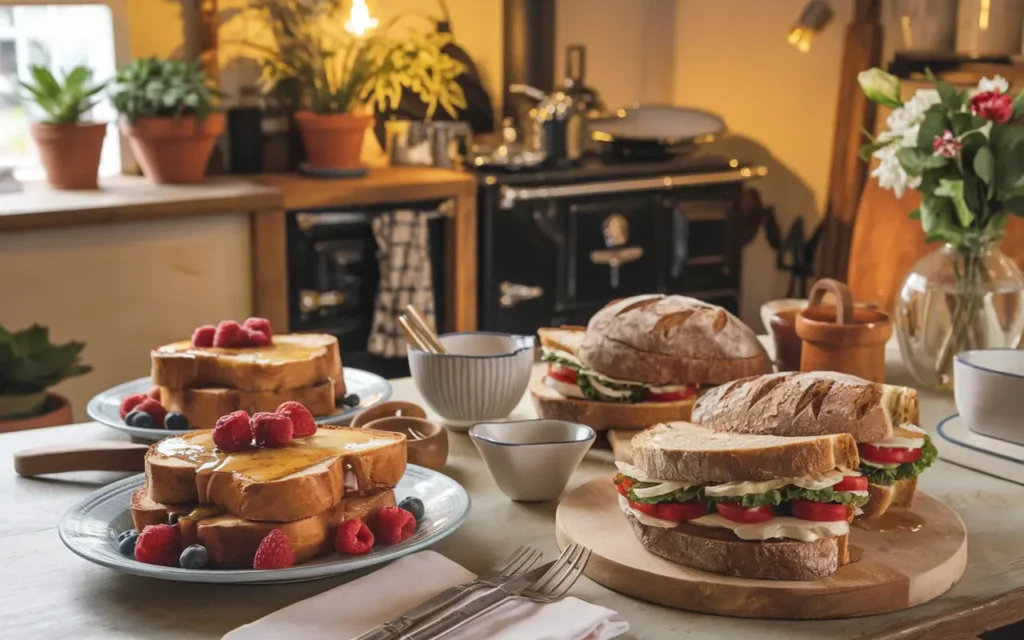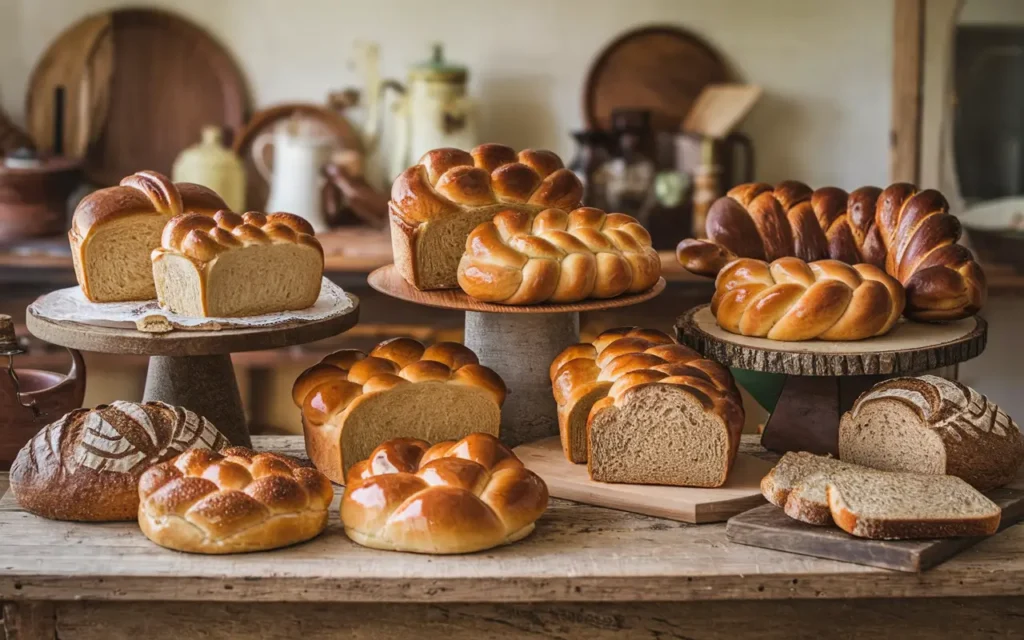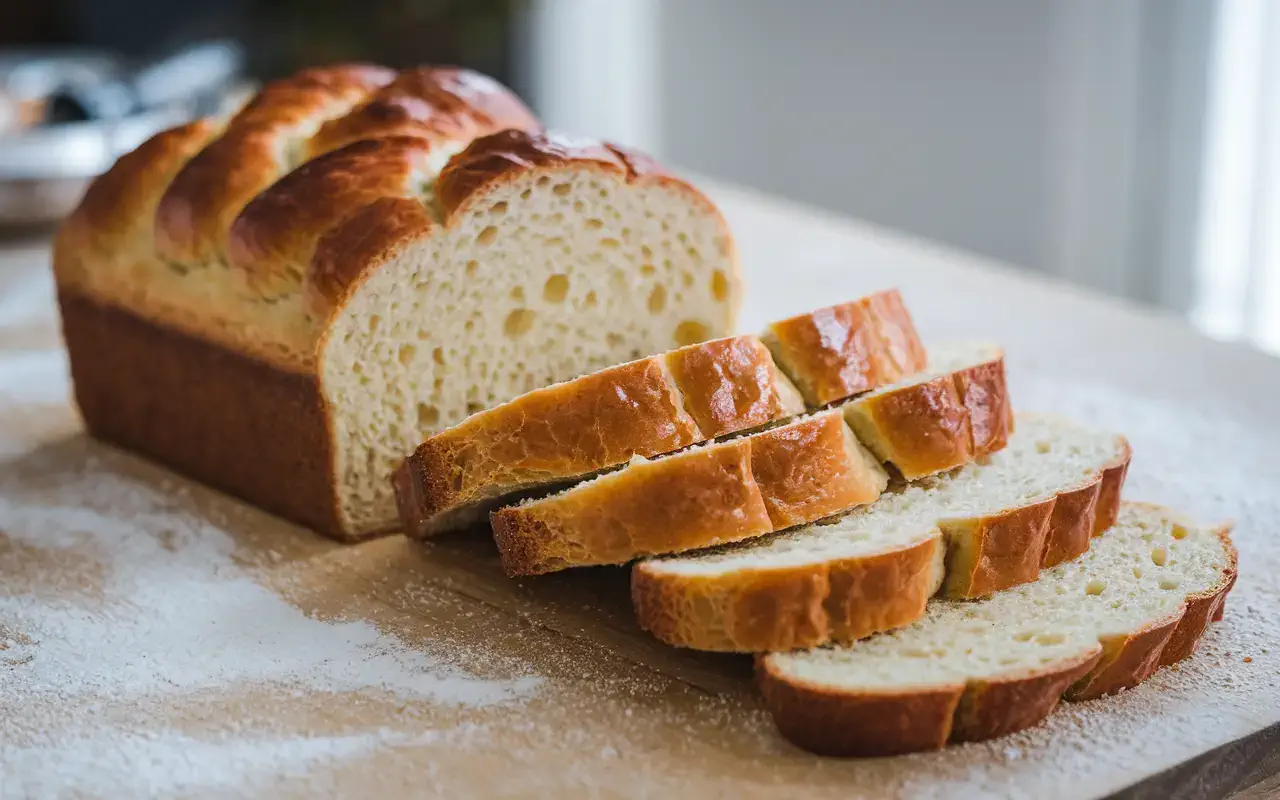Brioche is like the royalty of the bread world. It’s soft, golden, and buttery, with a texture so rich it almost feels like a dessert. Made with enriched dough that includes eggs, butter, and sometimes milk, brioche stands out for its luxurious taste. Imagine a fluffy cloud kissed with sweetness—that’s brioche for you! It’s perfect for making indulgent French toast, gourmet burgers, or even enjoying plain with a dollop of jam.
“Brioche is not just bread; it’s an experience—a buttery hug in every bite.” 🥐
The Origins of Brioche and Bread
A Brief History of Brioche
Brioche traces its roots back to France in the 15th century. Initially, it was a treat reserved for the elite because of its expensive ingredients, like butter and eggs. Over time, it became a symbol of luxury and indulgence. Some even speculate that the famous line, “Let them eat cake,” was actually referring to brioche. Whether true or not, this story underscores brioche’s status as a decadent delight.
Bread: A Staple Through the Ages
Bread, on the other hand, has been a cornerstone of human civilization for thousands of years. Ancient Egyptians were baking primitive forms of bread as early as 10,000 BC. From flatbreads in the Middle East to hearty rye loaves in Northern Europe, bread evolved to suit regional grains and culinary traditions. It’s no exaggeration to say that bread has been the lifeblood of cultures worldwide.
Key Ingredients: Brioche vs. Bread
The Role of Eggs and Butter in Brioche
One bite of brioche, and you’ll taste the difference. The secret? Generous amounts of butter and eggs. These ingredients transform ordinary dough into a rich, tender masterpiece. The butter adds flavor and softness, while the eggs provide structure and a beautiful golden hue. Without them, brioche would lose its signature melt-in-your-mouth quality.
Standard Ingredients in Bread
Bread, in contrast, relies on simplicity. Most recipes include just four ingredients: flour, water, yeast, and salt. These basics create a sturdy, versatile loaf that’s perfect for everything from sandwiches to soups. While bread may lack the richness of brioche, its simplicity allows it to adapt to countless variations.
Nutrition Facts: Brioche vs. Bread
| Nutritional Aspect | Brioche (per slice) | Bread (per slice) |
|---|---|---|
| Calories | ~150-200 | ~70-100 |
| Fat | 6-10g | 1-2g |
| Protein | 4-5g | 3-4g |
| Carbohydrates | 18-22g | 12-15g |
As you can see, brioche is richer in calories and fat, thanks to its butter and egg content. Bread, on the other hand, is lighter and better suited for those watching their calorie intake.
Texture and Appearance Comparison
Brioche: Fluffy, Buttery, and Golden
The moment you see a brioche loaf, you know it’s special. Its golden crust shines with a delicate sheen, and its soft, pillowy interior pulls apart effortlessly. The texture is rich and tender, making it a joy to eat even on its own.
Bread: Variations in Texture and Appearance
Bread is a chameleon—it can be crusty, chewy, or soft, depending on how it’s made. From the artisan charm of a rustic sourdough to the uniform slices of a white sandwich loaf, bread’s appearance and texture are as diverse as its uses.
Common Uses of Brioche and Bread
Culinary Applications of Brioche
Brioche isn’t just bread; it’s a versatile canvas for indulgence. Its buttery richness makes it perfect for elevating dishes that require a touch of luxury. Here are some popular ways to enjoy brioche:
- French Toast: Brioche’s soft, airy texture soaks up custard beautifully, resulting in the ultimate French toast. Add a drizzle of maple syrup and fresh fruit, and you’re in breakfast heaven. 🥞
- Gourmet Burgers: Swap out a regular bun for a brioche bun, and you’ve instantly taken your burger to the next level. The slight sweetness pairs beautifully with savory fillings. 🍔
- Desserts: Brioche is often used in bread puddings, cinnamon rolls, or even paired with chocolate spreads for a decadent treat. 🍫

Everyday Uses of Bread
Bread is the workhorse of the culinary world, and its uses are nearly endless. Here are some of the most common:
- Sandwiches: From PB&J to hearty deli stacks, bread is the foundation of countless sandwiches. 🥪
- Toast: Whether topped with butter, jam, or avocado, a slice of toast is a quick and satisfying option for any meal. 🥑
- Soups and Stews: Bread’s sturdy structure makes it ideal for dipping into soups and stews, soaking up all those delicious flavors. 🍲
Culinary Applications of Brioche
If you’re wondering why brioche is often considered the ultimate choice for French toast, it’s all about the texture and flavor. Brioche’s rich, buttery composition allows it to absorb the custard mixture beautifully without becoming soggy, resulting in a dish that is both indulgent and satisfying. Its slightly sweet taste pairs perfectly with toppings like maple syrup, powdered sugar, and fresh fruit. Compared to regular bread, which may lack the same richness, brioche elevates French toast to a gourmet experience. For more tips on making the best French toast and why brioche shines in this role, check out this article on AmoreRecipes. It’s packed with useful insights to make your breakfast or brunch unforgettable.
Nutritional Differences Between Brioche and Bread
Calories and Fat Content
One major difference between brioche and bread lies in their nutritional profiles.
- Brioche: Due to its high butter and egg content, brioche is calorie-dense, with approximately 150-200 calories per slice and 6-10 grams of fat.
- Bread: In contrast, a slice of plain bread typically contains 70-100 calories and only 1-2 grams of fat, making it a lighter option.
Vitamins and Nutritional Value
While brioche wins in taste and texture, bread often comes out ahead nutritionally. Whole-grain bread, in particular, is packed with fiber, B vitamins, and minerals like iron and magnesium, which contribute to a balanced diet. Brioche, though delicious, is more of a treat than a nutritional powerhouse.
“Think of brioche as the dessert of the bread world—amazing for special occasions, but maybe not your daily go-to.”
Baking Techniques: Brioche vs. Bread
The Art of Making Brioche
Making brioche requires patience and precision. Its enriched dough needs plenty of kneading to develop the gluten structure while evenly incorporating the butter. It also requires longer resting times to allow the dough to rise properly. The result? A light, airy loaf with a tender crumb that’s worth every bit of effort.
Traditional Bread-Baking Techniques
Bread baking is simpler and more forgiving. Basic recipes involve combining flour, water, yeast, and salt, followed by kneading and proofing. The beauty of bread lies in its adaptability—add seeds, herbs, or even cheese, and you’ve got a whole new creation.
Common Problems When Baking Brioche and Bread
Why Does My Brioche Turn Out Dense?
A dense brioche usually happens when the butter or eggs aren’t properly incorporated. Another culprit could be under-kneading, which prevents the dough from developing enough gluten to create that fluffy texture.
Solving Bread-Baking Issues
Bread baking isn’t without its challenges, either.
- Flat Loaf: If your bread isn’t rising, it might be due to inactive yeast or an overly cold environment.
- Too Hard: A thick, hard crust often results from baking at too high a temperature or overbaking.
Popular Variations of Brioche and Bread
Types of Brioche: Loaves, Buns, and More
Brioche isn’t confined to a single form; it comes in a variety of shapes and styles that cater to different culinary needs.
- Classic Brioche Loaf: Perfect for slicing and using in French toast or sandwiches. Its rich, golden crust makes it a showstopper on any breakfast table.
- Brioche Buns: These are a favorite for gourmet burgers and sliders. Their soft texture and slight sweetness balance savory fillings beautifully.
- Braided Brioche: Often seen during holidays, this style adds a decorative twist to your table while maintaining that buttery, soft interior.

Bread Varieties: Sourdough, Whole Wheat, and More
Bread, on the other hand, has a universe of variations, each with its unique flavor and texture.
- Sourdough: Known for its tangy flavor and chewy texture, sourdough is made using a fermented starter instead of commercial yeast.
- Whole Wheat Bread: Packed with fiber and nutrients, this bread is a healthier option for everyday meals.
- Rye Bread: Popular in Scandinavian and Eastern European cuisines, rye bread has a dense texture and a slightly sour taste.
Cultural Significance of Brioche and Bread
Brioche in French Cuisine
In France, brioche is more than just food—it’s part of the culture. It’s often served at celebratory events like weddings or Easter. The delicate, buttery flavor embodies the French dedication to culinary excellence.
Bread Across Cultures
Bread, by contrast, has deep roots in almost every culture. From naan in India to tortillas in Mexico and baguettes in France, bread serves as a universal symbol of sustenance. It’s a unifying food that transcends borders.
Which Is Better for You: Brioche or Bread?
When to Choose Brioche
Brioche is your go-to for indulgence. Whether you’re making a decadent dessert or treating yourself to a fancy burger, brioche adds a touch of luxury to your meal. However, it’s best enjoyed in moderation due to its high calorie and fat content.
The Healthier Bread Option
If health is your priority, traditional bread, especially whole-grain varieties, is the better choice. It’s lower in fat, higher in fiber, and provides essential nutrients that support overall well-being.
“Brioche is like a fancy dessert, while bread is your reliable everyday hero.”
Conclusion: The Unique Charm of Brioche and Bread
Final Thoughts on Their Differences
While brioche and bread may seem similar, they serve very different purposes. Brioche is all about indulgence and luxury, while bread focuses on simplicity and versatility. Each has its place, depending on what you’re craving or cooking.
Choosing the Right One for Your Needs
When it comes down to it, the choice between brioche and bread depends on your needs. Craving something rich and buttery? Go for brioche. Need a reliable base for a sandwich? Bread’s your answer. Either way, both are delightful in their own right.
“Whether you’re savoring a slice of brioche or enjoying a crusty piece of bread, there’s no wrong choice—just delicious possibilities.” 🍞🥐

Classic Brioche: A Luxurious French Bread Experience
Equipment
- Large mixing bowl
- Stand mixer with dough hook (optional)
- Measuring cups and spoons
- Whisk or fork
- Baking pan or loaf pan
- Plastic wrap
- Cooling rack
- Ingredients:
Ingredients
- 3 1/2 cups all-purpose flour
- 1/4 cup granulated sugar
- 2 1/4 teaspoons active dry yeast
- 1 teaspoon salt
- 3 large eggs at room temperature
- 1/2 cup whole milk warmed to about 100°F (38°C)
- 1/2 cup unsalted butter softened and cut into pieces
- 1 egg beaten (for egg wash)
Instructions
- Activate the Yeast:
- In a small bowl, combine the warm milk and active dry yeast. Let the mixture sit for 5–10 minutes until it becomes frothy.
- Mix Dry Ingredients:
- In a large mixing bowl, whisk together the flour, sugar, and salt.
- Combine Wet Ingredients:
- Make a well in the center of the dry ingredients. Add the eggs and the yeast mixture, stirring until a shaggy dough forms.
- Knead the Dough:
- Transfer the dough to a lightly floured surface and knead for about 10 minutes (or use a stand mixer with a dough hook on low speed) until the dough becomes smooth and elastic.
- Incorporate the Butter:
- Gradually add the softened butter, kneading continuously until fully absorbed and the dough turns glossy and pliable.
- First Rise:
- Place the dough in a greased bowl, cover with plastic wrap, and let it rise in a warm spot for 1–2 hours, or until doubled in size.
- Shape the Dough:
- Gently deflate the risen dough, shape it into a loaf, and place it in a greased baking pan or loaf pan.
- Prepare for Baking:
- Preheat your oven to 375°F (190°C). Brush the top of the shaped dough with the beaten egg to achieve a shiny, golden crust.
- Bake:
- Bake in the preheated oven for 20–25 minutes until the brioche is deep golden and sounds hollow when tapped on the bottom.
- Cool and Serve:
- Remove from the oven and let cool on a wire rack. Slice and enjoy fresh, or toast for an extra special treat.
Notes
If the dough feels too sticky during kneading, add a light dusting of flour—but be cautious not to add too much to maintain a tender crumb.
For an even richer flavor, you can substitute a portion of the all-purpose flour with bread flour.
Nutrition (per slice, based on 8 slices per loaf):
Approximately 200–250 calories, depending on the precise ingredients used.

